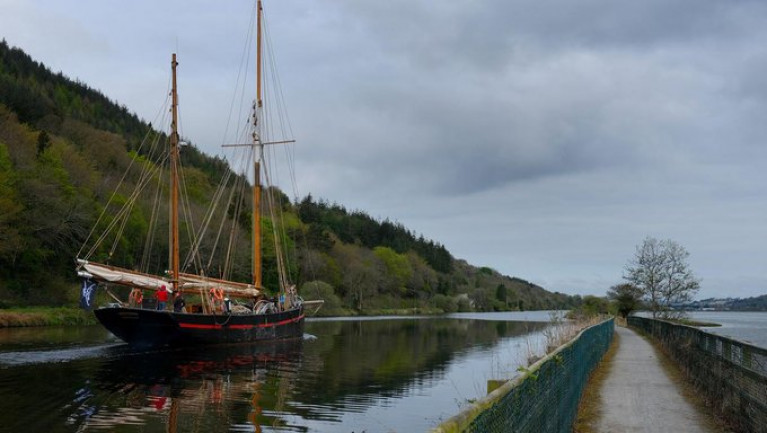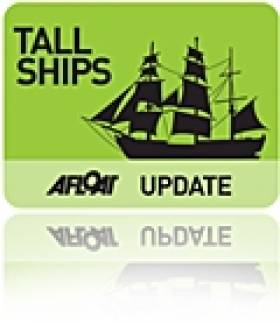Displaying items by tag: Brixham trawler
A 130-year-old heritage tall ship named ‘Leader’ has docked in Newry, Co.Down where it will be used for the benefit of the local community.
The Brixham trawler was formerly a survivor of the fleets of sailing fishing boats that once fished in the Irish Sea.
Northern Ireland Sailing Charity, Silvery Light Sailing, has received a National Lottery Heritage Fund grant of £244,975 for the acquisition of the 1892-built heritage tall ship to host community sailing programmes and further expand their traditional boat building skills workshops.
Sailing from Bristol’s Underfall Yard after dry docking and a maintenance refit, the 130-year-old Brixham trawler, arrived at the Albert Basin in Newry, County Down.
The heritage vessel is again destined to become a familiar sight in Northern Ireland’s ports providing a unique sailing experience for local youth and community groups, public open days and festivals.
Further coverage from the Belfast Telegraph and also from Silvery Light Sailing’s social media channels @SilveryLight.
Vintage Brixham Trawler 'Leader' Acquired by Northern Ireland's Silvery Light Maritime Heritage Charity
Silvery Light Sailing is Northern Ireland’s only Maritime Heritage Community Boatworks and Sail Training Charity and it has just been awarded a National Lottery Heritage Fund grant of £244,975 for the acquisition of the 1892-built Heritage Tall Ship Leader and a further expansion of their traditional boat building skills workshop and community sailing programmes.
The 130-year-old Brixham trawler will sail into Newry in south County Down where the charity is based, in the coming weeks.
She was built in for William Robbens by the yard of A W Gibbs at Galmpton Creek on the River Dart, two miles from Brixham.
The funding for the Summer 2022 Maritime Heritage Project has been made possible by National Lottery players who raise more than £30 million every week for good causes in the UK. The project opens a new chapter in the history of the LEADER, a survivor of the fleets of sailing fishing boat that once fished in the Irish Sea. The Heritage vessel is again destined to become a familiar sight in Northern Ireland’s ports providing a unique sailing experience for local youth and community groups, public open days and festivals. Maintained and crewed by volunteers, the project will help preserve an important link to the area’s rich maritime and fishing past.
 The Silvery Light Sailing Community Workshop
The Silvery Light Sailing Community Workshop
Gerry Brennan, Chair of Silvery Light Sailing is excited to get this project off the ground: “We are a maritime charity providing an annual programme of residential voyages that give youth and community groups from across Northern Ireland an opportunity to experience and benefit from a taste of life at sea on a traditional sailing ship. For many, it can be a life-changing, challenging experience, discovering new strengths and self-confidence whilst making lasting friendships”
Ten community and youth groups from across Northern Ireland will follow a programme of heritage workshop skills and a five-day residential voyage. They will form the crew sailing the ship using the power of the wind, learning about the traditions of the sea, how to cook, clean, maintain and care for both themselves and the heritage vessel.
Dr Paul Mullan, Director, Northern Ireland at The National Lottery Heritage Fund said: “It is fantastic news that, thanks to the National Lottery players, we have been able to support Silvery Light Sailing to ensure that this amazing heritage tall ship can be preserved for years to come, meaning that local communities and visitors can learn more about Northern Ireland’s maritime heritage. We know that heritage can play a huge role in bringing people together and the community sailing programmes that will be accessed by groups engaging with maritime heritage for the first time is a fantastic example of that.”
Leader was built as a sailing trawler. Uniquely during each voyage, crews will undertake sea sampling experiments using mini trawling methods to determine the level of microplastic pollution around our coastline.
Through community workshops, Silvery Light Sailing practice traditional skills and methods for the maintenance of Tall Ships like LEADER and the restoration of several smaller heritage boats which have a local connection. This new National Lottery funded project has not only secured an important part of Northern Ireland’s maritime heritage but allows for the expansion of workshop activities and the opportunity to bring in more volunteers.
Silvery Light Sailing welcomes new volunteers and for information on available opportunities to volunteer as a crew member or to learn about boat restoration.
News of future public events and opportunities to board Leader will be available shortly.
One of the more recent refurbishment projects carried out by Silvery Light Sailing was the restoration of the MV Joyce, a 40-foot naval Torpedo Recovery Boat used during World War 11 on Lough Neagh.
Leader should arrive in Newry around 29 March 2022.
100 Days to Waterford's Tall-Ships Festival
is to draw 500,000 visitors from home and abroad. The festival is to be presented by Szczecin and organised by the Sail Training International.
Over 70 of the worlds tall-ships of all shapes and sizes will sail up the River Suir to take up residence on both sides of Waterford's city centre quays, where a major meeting of over 1,500 trainee sailors stretching from far and distant shores are to congregate.
One of the attending Class 'A' fully rigged ships, Christian Radich, which was built in 1937, incidentally provided sail-training opportunities for Irish trainees in an arrangement between her Norwegian owners and Coiste an Asgard. The sail-trainee agreement in 2009 followed the sinking of Coiste an Asgard's brigantine the Asgard II in the previous year. This was to be the last season of the state-owned sail training agency which was axed in the 2009 budget.
Another 'A' lister is the UK flagged Royalist, a brig built by Groves and Gutteridge in Cowes, Isle of Wight to a design by Colin Mudie. The 40 year old brig was named by HRH Princess Anne in 1971 for the Sea Cadet Association. She may be small for an 'A' class at just 28-metres long but the vessel can easily be spotted with her distinctive black and white painted hull.
While one of the oldest vessels to participant is the 87 year-old Brixham built trawler Provident, which along with Leader, are the only 'sailing' survivors of a once numerous traditional North Sea fishing craft. The 95-foot vessel was built at Galmpton on the River Dart. In 1991 there was a major refit of the 85 tonnes craft which has since 1999 worked from Brixham as part of the Trinity Sailing Foundation.
The event which is billed as the largest Irish festival in 2011 also presents young Irish people to experience a once in a lifetime opportunity to set sail onboard a tall-ship. The opportunity is open to those aged 16 or over by June 30 and are fit and active to be a trainee on the inaugural race leg from Waterford to Greenock (departing 3 July). For details click here.
On this date the eagerly awaited 'Parade of Sail' is set to depart the crystal city downriver on the Waterford Estuary and out into the open sea.
Looking for further reading on Tall Ships in Ireland? Click the links below:
Click this link to read all our Tall Ships Stories on one handy page
Previewing Ireland's Tall Ships 2011 Season
Can Ireland Get a New Tall Ship?






























































